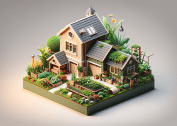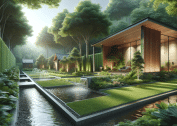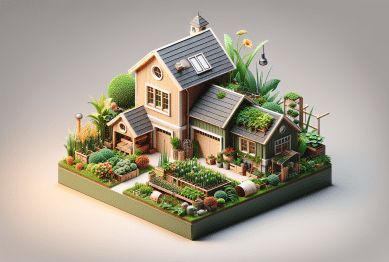Container gardening opens exciting possibilities for anyone seeking a vibrant home oasis, even with limited space. Discover simple techniques, plant selections, and soil secrets that bring lush color and harvests to balconies, patios, or inside your living room. This guide explores expert container gardening tips for a thriving home garden.
Why Container Gardening Works for Any Space
Container gardening has transformed the way people interact with plants in modern homes. With more people living in apartments or houses with restricted outdoor areas, the appeal of growing flowers, herbs, or even vegetables in pots has never been higher. What makes this approach unique is its flexibility. Containers can be moved or rearranged with ease, making it possible to follow the sunlight, avoid extreme weather, or simply reimagine your interior design. For city dwellers, balconies and window sills become mini-gardens bursting with greenery. Even homes with ample yard space often combine beds and containers for creative flair. The popularity of container gardening continues to rise as it adapts to every lifestyle and location, ensuring beauty and fresh produce are always within arm’s reach.
Many plant lovers find container gardening allows for experimentation and learning without heavy commitment. If a plant is not thriving, it’s simple to try a new spot or replace the soil. Children and adults alike engage quickly, watching seeds sprout on kitchen counters or tending blooms near their favorite seating areas. Some plants, like culinary herbs, respond especially well to small pots, offering fragrance and flavor for everyday meals. Others opt for dwarf fruit trees or vegetables that add visual interest and nutrition. Each arrangement offers opportunities to blend color, fragrance, and shape in imaginative ways. By design, container gardening puts control directly into the gardener’s hands, making the hobby accessible at every skill level.
But flexibility extends past aesthetics. Container gardening provides practical benefits, including improved pest management and easier soil control. Many common pests are less problematic in elevated pots versus open beds. It’s also possible to provide precise water and nutrients suitable for specific plant types. Gardeners often select high-value keywords like ‘best vegetables for pots’ or ‘small space flower arrangements’ as they research effective container options. This shift has fueled a robust online community sharing advice, product reviews, and inspiring results. Whether you want to grow fresh salads, display vibrant blooms, or create green privacy screens, container gardening truly works for any space you call home.
Choosing the Right Containers for Success
The first big decision: which type of container fits your environment and gardening goals? Options include classic terracotta, modern resin, lightweight plastic, recycled materials, or elegant ceramic. Each comes with unique advantages. Terracotta offers breathability and a warm, timeless appearance but dries out quickly. Plastic and resin pots are lightweight and retain moisture, making them ideal for hot climates or those prone to forgetting a watering session. Even creative choices—like upcycled buckets or wooden crates—bring personality while functioning well when drainage is added. Matching container size to the type of plant is crucial. Root-bound herbs often need deeper pots, while succulents thrive in shallow dishes with ample drainage holes. Understanding the functional needs of your chosen greenery lets you select not only beautiful containers but also practical ones that boost plant health.
Color and style matter too. Some gardeners coordinate pots to complement home décor or use bold shapes as focal points. Others prefer rustic mismatched vessels for a cottage feel. The container itself can influence temperature regulation and sunlight absorption. Darker pots warm soil faster, benefiting heat-loving plants, but may require careful monitoring to prevent wilting. Light-colored or glazed containers stay cooler and reduce water loss. Regardless of aesthetic, adequate drainage is essential to prevent root rot. Before planting, ensure drainage holes are present and add an inch of gravel or shards at the base to support healthy roots. That simple precaution can prevent many common issues in container gardening from the start.
Durability and ease of handling also deserve attention. Many homes and balconies cannot support excessive weight, making lightweight materials preferable, especially for large or hanging arrangements. Wheeled saucers or caddies assist with rearranging heavy pots. Self-watering containers offer a boost in arid climates or busy households. Recommendations for the ‘best type of container’ vary, but most successful gardeners mix several types based on use and climate needs. By choosing containers that fit both your style and the requirements of your plants, you pave the way for a flourishing home garden.
Soil Secrets and Fertilization in Containers
Potting soil composition makes all the difference in container gardening, far more than traditional garden beds. Unlike the ground, potted plants rely entirely on what’s within the container. It’s tempting to use plain garden soil, but this can be too dense, limiting oxygen and water movement. High-quality potting mixes balance drainage, water retention, and nutrient supply, often featuring peat, coconut coir, perlite, or vermiculite. These ingredients create pockets for air and moisture. For most plants, a lightweight, well-aerated mix supports robust root growth and prevents soggy, unhealthy conditions. Periodically, soil health may wane as nutrients become depleted—especially after heavy blooms or harvests. That’s where feeding strategies come into play. Some opt for organic fertilizer blends, integrating slow-release pellets or compost. Others choose liquid nutrients tailored to the lifecycle of flowers, vegetables, or herbs. Consistent but measured feeding helps maintain strong foliage, healthy blooms, and productive edible plants throughout the season.
Drainage deserves extra focus in containers. Because pots restrict root spread, overwatering or poor drainage quickly leads to root diseases. Always ensure excess water can escape, and avoid letting containers sit in standing water for long periods. Mulching the soil surface with bark, decorative pebbles, or straw can reduce evaporation, stabilize temperature, and improve appearance. Container soils often require frequent testing. Using a finger check or moisture meter helps determine when it’s time to water. Some plants, like succulents, prefer dry spells, while vegetables and annuals require more frequent moisture. Optimizing soil and watering practices leads to vibrant containers brimming with health.
Rejuvenating old potting soil prevents many common problems. At the start of each season—or after a crop cycle—consider removing a portion of the used mix and blending in fresh amendments like compost or peat. A top-dressing of fertilizer in early spring or at planting time sets young plants up for robust growth. Avoiding chemical fertilizers with excessive nitrogen can help prevent leggy, weak plants. Instead, slow-release organics or compost teas provide steady nutrition. By treating soil as a living foundation, container gardeners unlock the full potential of their plants, achieving results equal to, or often better than, traditional garden beds.
Top Plant Choices for Thriving Container Gardens
One joy of container gardening is the vast array of plant options to suit any style or need. Flower lovers often select annuals such as petunias, marigolds, and geraniums, which provide nonstop color. Perennials like lavender or coreopsis add fragrance and return year after year. For dramatic displays, mix trailing plants, upright species, and foliage types in a single pot, creating layers of texture and interest. Edible gardens in containers continue to gain popularity. Favorites include cherry tomatoes, salad greens, peppers, and compact varieties of eggplant or beans. Herbs like basil, thyme, mint, and parsley thrive even on sun-drenched windowsills, making healthy flavors convenient for home cooks. Container gardening also gives a chance to grow specialty plants—such as succulents, orchids, or citrus trees—that may not suit open garden spaces. These can be moved indoors in colder weather, extending their enjoyment. The key is choosing species adapted to your climate and container size, plus those that spark curiosity and delight.
Some gardeners embrace niche plant families like cacti, bromeliads, or ferns. These plants suit specific light and moisture needs and can create dramatic focal points indoors or outdoors. Hanging baskets of trailing fuchsias or English ivy soften balconies and porches. For statement pieces, consider dwarf shrubs, compact roses, or even small fruiting trees. As more people explore organic gardening, varieties proven to thrive without pesticides gain attention. Browsing local garden centers or online plant guides yields inspiration and helps match plant choices to conditions at home. Whether aiming for continuous blooms, fragrant herbs, or fresh salad ingredients, container gardening scales up or down as needed.
Combining ornamentals with food crops creates attractive, functional displays. For example, nasturtiums interplanted with lettuce naturally deter pests while adding edible flowers to salads. Calendula and chives grow harmoniously, attracting pollinators. Tall plants like tomatoes can be underplanted with smaller herbs or leafy greens. This layered approach not only maximizes space but also boosts productivity and visual appeal. Container gardens are ultimately as unique as their caretakers, reflecting personal preferences and seasonal inspiration. Experimenting with new varieties each year keeps the process exciting, while proven favorites guarantee a harvest or color show to look forward to.
Watering, Light, and Climate Tips for Containers
Mastering the basics of watering and light transforms container gardens from ordinary to extraordinary. Potted plants often need more frequent watering than those in the ground because pots heat up and dry out quickly, especially in summer. Early morning or late afternoon watering helps reduce evaporation and stress. A simple check with a finger or moisture probe prevents both underwatering and overwatering—two of the most common issues for indoor and patio gardens. Layering mulch, as mentioned earlier, further conserves moisture and shields roots from temperature swings.
Sunlight is another key factor. Most vegetables and flowering annuals require at least six hours of direct sun, while ferns, coleus, and many houseplants thrive in dappled shade or north-facing windows. Rotating containers every week ensures even growth and prevents leaning towards a light source. When arranging pots on a balcony or windowsill, placing taller or sun-hardy plants as a buffer for shade-loving varieties can benefit all. In regions prone to strong winds or heat, clustering pots together helps maintain humidity and reduces exposure—think of your containers as microclimates, each requiring observation and occasional adjustment for best results.
Climate also shapes container gardening choices. In cooler areas, frost-resistant pots and portable containers allow tender species to be moved indoors as the seasons shift. Self-watering systems or water-absorbing crystals support gardeners in dry, arid zones. Researching recommendations such as ‘plants for full sun containers’ or ‘shade loving potted plants’ helps optimize your collection. By paying attention to these fundamental needs, gardeners can enjoy lush, productive containers in nearly any setting.
Creating Visual Impact and Personal Style
Beyond basic care, many find satisfaction in shaping a unique visual style with their container gardens. Effective arrangements often combine ‘thrillers’ (tall focal plants), ‘fillers’ (midsize, bushy varieties), and ‘spillers’ (cascading plants) in each pot. This method results in a balanced, lush look that’s easy to refresh as seasons change. Color themes or repeating shapes add cohesion, whether you love rustic, modern, bright, or pastel palettes. Container placements—lining entryways, accenting seating areas, or framing views from windows—invite people into the garden experience, making plant care a regular, joyful routine.
Creative touches abound. Unusual container choices, such as galvanized tubs, chipped teapots, or vintage crates, add character. Combining succulents with pebbles or moss evokes desert landscapes, while a mass of ferns in a ceramic planter channels woodland style. Seasonal displays—think autumn mums or winter evergreens—ensure containers dazzle year-round. Small-scale vertical gardens offer another way to maximize impact, especially in compact spaces. With imagination, even a single well-chosen pot becomes a statement piece.
Personalization is the ultimate pleasure—some add garden art, painted pots, or solar lights. Others select plants for memories or symbolic meanings, turning patios and lounges into living collages. Sharing photos, swaps, or stories online fosters community among container gardeners, fueling inspiration. No matter the approach, the process is about creativity, connection, and the ongoing discovery of what grows well and sparks joy in every corner of home or garden.
References
1. National Gardening Association. (n.d.). The basics of container gardening. Retrieved from https://garden.org/learn/articles/view/1315/
2. Royal Horticultural Society. (n.d.). Guide to container gardening. Retrieved from https://www.rhs.org.uk/advice/container-gardening
3. University of Illinois Extension. (n.d.). Container gardening. Retrieved from https://extension.illinois.edu/container-gardening
4. University of California Master Gardener. (n.d.). Success with container gardens. Retrieved from https://ucanr.edu/sites/mgslo/files/274255.pdf
5. Missouri Botanical Garden. (n.d.). Potting soils for container gardening. Retrieved from https://www.missouribotanicalgarden.org/gardens-gardening/your-garden/help-for-the-home-gardener/advice-tips-resources/gardening-help/factsheets/potting-soils-for-container-gardens
6. Penn State Extension. (n.d.). Growing ornamentals and edibles in containers. Retrieved from https://extension.psu.edu/container-gardening-for-ornamentals-and-edibles









